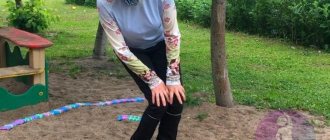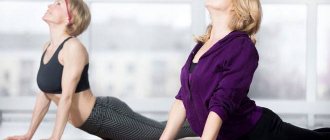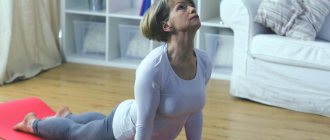Instilling a love of exercise is difficult. Even adults find it much more interesting to scroll through their feed on social networks or watch a movie, and even more so for children. And if you don’t want your child to lead an exclusively sedentary lifestyle, start introducing sports into his life gradually. Morning exercises for children can be a great start for more serious sporting achievements or simply remain a healthy habit for your child forever.
Make sure your children are okay when they are left without your attention. Install the “Where are my children” application to always know where your child is, what is happening around him, and how he is feeling.
Content:
- Why do you need exercise in the morning? What features need to be taken into account for exercise to bring maximum benefit?
- Safe charging conditions
- Warm-up
- General exercises for children 6-10 years old Stretching exercises
Why do you need exercise in the morning?
Regular morning exercise is more important for children than for adults. Preschoolers and schoolchildren are forced to lead a less active lifestyle, being mostly indoors - which is why children so often have problems with posture, weight, and physical development in general.
A simple home routine, regularly performed in the morning, has only a positive effect on the child’s body:
- strengthens the immune system, which primarily suffers from insufficient physical activity;
- strengthens the spine, which may develop incorrectly due to a sedentary lifestyle;
- improves the functioning of the cardiovascular system: children who regularly do morning exercises are less likely to experience weakness and are less susceptible to changes in blood pressure and fainting;
- strengthens the muscle corset, maintaining a healthy back and beautiful posture;
- fosters determination and the ability to plan.
As a professional, I’ll say this: everyone needs exercise: seniors and juniors. Regardless of age, minimal physical activity should be present in the life of every person: strengthening the muscle frame, body tone and good spirits - this is the minimum set of reasons “why exercise is needed.” If parents teach their child to be physically active from an early age, then in the future he will do exercises on his own. Of course, to make it easier for your child, you should do all the exercises together,
– Anton Golotsutskov,
Russian gymnast, Olympic medalist, champion of Russia and Europe, president of the charitable foundation “Health for Children through Sports.”
What features of morning exercises need to be taken into account to ensure that the exercises are safe and bring maximum benefit:
- exercises are performed on an empty stomach, after hygiene procedures - exercise does not involve high loads, and you can have breakfast immediately after completing the complex;
- maintain regularity - only systematic exercises have a positive effect;
- do not overdo it with the duration of the exercise - for children under ten years old it is enough to spend 10-15 minutes on exercises;
- take time to warm up - you can start preparing the child’s body for physical activity immediately after waking up, while the child is still lying in bed, using the simplest movements: raise and lower your arms, twirl your hands, clench and unclench your fingers;
- If possible, do exercises outside; if that doesn’t work, then in a well-ventilated area;
- try to diversify the activities taking into account the child’s age: turn on fun music or a suitable video lesson, add new exercises every two weeks;
- teach your son or daughter to breathe correctly: inhale through the nose, exhale through the mouth - correct breathing makes it easier to do morning exercises and makes it more effective;
- follow the principle “from simple to complex”, gradually complicating the complex and giving the child enough time - at least two weeks - to get used to the same load;
- do not interrupt the exercises abruptly, include the final stage in the complex: for example, stretching, running or walking in place;
- Teach your child to finish classes with water procedures: contrast showers, douches.
Charging must be done in a ventilated area, immediately after waking up and before eating. I recommend it with energetic music that your child likes to set him up positively for the whole day. Be sure to monitor the correct execution and breathing. If a child is sick or feels unwell, classes should be interrupted until he returns to normal.
– Anton Golotsutskov,
gymnast, Olympic medalist, Russian and European champion, president of the Children's Health through Sports Foundation.
Safe charging conditions:
- choose suitable clothing for training: made from natural fabrics, without large seams, without zippers and without buttons - the training uniform should not create inconvenience;
- when exercising at home, you don’t have to wear shoes, but socks are a must;
- prepare a place for charging: make sure there is enough space in the room, remove objects from the floor that could accidentally injure the child, if necessary, prepare sports equipment (jump rope, ball, mat).
Morning exercises can only be harmful if the exercises are performed incorrectly, as well as the individual characteristics of the child. If there are any, consult your doctor, he will tell you which exercises you can use and which ones are best avoided. In any case, proper gymnastics cannot harm, you just need to take into account the level of possible stress,
– Anton Golotsutskov,
gymnast, Olympic medalist, Russian and European champion, president of the Children's Health through Sports Foundation.
Rules for effective morning exercises
Main rules:
- From the moment you wake up, it is desirable to restore the body’s water balance, so for this you should drink 1-2 glasses of clean water.
- Exercises should be performed on an empty stomach: this will allow you to burn 20% more fat than after eating.
- When performing physical exercises, you need to consider the temperature in the room. The lower it is, the smoother and calmer the exercises with which the charging begins will be.
- The first should be loads for the upper body , and then you need to gradually lower down, finishing with exercises for the legs.
- The sequence of physical exercises should be strict: the least intense ones are performed first, and then exercises are performed as the intensity increases. This program will help you gradually get out of a calm state.
- The exercise should include from 5 to 10 exercises , each of which must be repeated at least 10 times. For beginners, you can reduce it to 5-7 exercises. The duration of classes is from 15 to 30 minutes.
- Exercise should be fun , so all movements should be done lightly, but not too lazy. Clothing should be comfortable and not restrict movement.
- It is important to exercise regularly: this is the only way to keep your body fit and slim.
How to get your child interested in doing exercises
For senior preschool (6-7 years old) and primary school (8, 9, 10 years old) children, activities that are not designated by parents as strictly mandatory are interesting. The easiest way to involve children in doing exercises is for parents to start doing the exercises themselves: a preschooler will probably want to repeat after an adult, and a schoolchild will at least ask what exactly mom or dad are doing.
You can start teaching exercises as early as 2-3 years old. At first it will be basic exercises, literally 5 minutes of warm-up every morning. Already closer to school age, in the period from 6 to 10 years, we increase the charging time to 10-15 minutes and the complexity of the exercises accordingly,
– Anton Golotsutskov,
gymnast, Olympic medalist, Russian and European champion, president of the Children's Health through Sports Foundation.
How to strengthen your child’s interest in morning exercises:
- introduce game elements into daily tasks - for children 6-8 years old. For example, imagine together that you have come to a magical clearing and now you need to wave your arms like a butterfly’s wings, bend over as if picking flowers, jump like a cheerful bunny;
- choose music for classes: you can use the same music, and exactly the one that the child likes. Doctors specializing in physical therapy claim that upbeat music helps a person at any age get in the mood for physical activity;
- replace - constantly or sometimes - regular training with poetic exercises - for children 6-7 years old. Suitable poems can be included on audio, video, or spoken out yourself. Option for children's exercises with poems:
- Praise your child every time he completes a routine. Remind him that every day his body becomes more physically strong and healthy, and his muscles become more beautiful.
An enthusiastic child who understands why he is engaged in physical education will perform all the tasks provided for in the morning routine. Some children are so inspired by their initial successes that they begin to exercise too intensely, and as a result they become tired and do not feel energetic enough during the day. If your child is too persistent in doing exercises, remind him that the purpose of exercise is to awaken the body, not tire it, and suggest creating a training plan:
- a plan for each day - drawn up on the eve of each lesson: all the exercises of the complex are prescribed in the plan and marked where additional equipment will be useful;
- a plan for introducing new exercises - done in the form of a table, noting with what frequency new exercises will appear in the complex;
- a long-term plan is prepared for a long period of time: for a week or a month, marking the sequential mastery of the complex’s classes and the introduction of new exercises.
Write down the planned lesson plan on a piece of paper and place it in a visible place. Together with your child, you can draw up a plan beautifully and ask your son or daughter to independently celebrate the planned achievements - direct participation in drawing up the plan will motivate the child to study constantly, without doing unnecessary exercises.
Set of exercises (photos, pictures)
On the legs and buttocks
For losing weight in your legs, the most effective exercise is walking. If you don't walk much during the day, then start your routine by walking in place for 30-60 seconds, while raising your knees high. Follow the rhythm of breathing, 4 steps - inhale, the next 4 steps - exhale. Grasp the back of the chair with your hands, stand on your toes, rise and fall for 30-60 seconds, see the picture for more details.
Perform jumps on each leg separately and at the end on both, about 30-40 seconds, at the end of the exercise repeat walking in place. Read more about this in the article exercises for losing weight on legs.
Video
On the stomach and sides
Feet shoulder-width apart, we perform circular rotations with the pelvis, while the stomach must be pulled in and vice versa, protruded throughout the entire exercise. A great option to remove a sagging belly. Lie on your back and begin to protrude your abdominal cavity, pressing on it with both hands. Repeat about 10 times. Read more about this in the article exercises for losing weight in the abdomen and sides.
Video
In your arms
We select dumbbells of a weight that is convenient for you, from 1 kilogram and above. Raise both arms at the same time to the sides, for about 30-60 seconds, depending on your level of endurance. Read more about this in the article exercises for losing weight on your arms.
Video
On the hips
In a lying position, bend your legs so that your feet remain on the floor, raise your pelvis and move it to the right and left, springing 6 times in each direction. Do several approaches of this exercise. Read more about this in the article exercises for losing weight on thighs.
Video
This set of exercises is the simplest and is quite suitable for a light workout for 10-15 minutes, while you devote them to your body and can combine them with watching your favorite show. Also, do not forget that evening exercise for weight loss is also an integral part of losing weight, and will greatly help you lose excess weight. In the evening, exercise should be light, best with elements of stretching; 10-15 minutes of express exercises at night are enough, and your body will thank you.
Where to begin
Starting from the very first lesson, make sure to perform the exercises at the correct pace.
How to maintain a safe and efficient pace for your child during morning exercise:
- Follow the principle of any workout: warm-up - main part - final part (cool-down). Even beginning athletes usually remember to warm up, but the cool down is often neglected. The final stage of physical activity is as important as all the others - let the child finish the exercise with a slow step in place or simple stretching exercises.
- Set the correct speed when performing exercises: first slowly and gradually accelerating, move on to the fastest possible version of the movements. You also need to slow down little by little—pediatricians do not recommend that children, especially preschool and primary school age children, suddenly stop fast movements.
- Remember that quality is more important than quantity - let the child do deep bends to the sides five times, observing breathing technique, rather than perform twenty quick shallow bends, forgetting about proper breathing.
Warm-up
Warm-up is needed to prepare and “warm up” the muscles and joints. If you skip the warm-up and go straight to the main part of the workout, there is a high risk of injury. Warm-up option for preschoolers, spend about one minute on each exercise:
- walking in place;
- running in place at a calm pace;
- wave your arms.
A warm-up for a preschooler can be accompanied by a story about the exercises that you will do in the main part of the workout, or you can start a fairy tale that leads to the start of the main classes.
Where to start morning exercises for a child - a warm-up option for elementary school students:
- bends: hands on the belt, bends are performed sequentially - left, right, forward, backward;
- rise on toes (5-6 repetitions): inhale - spread your arms wide to the sides, exhale - stretch up on your toes as high as possible, stay in this position for a short time and lower;
- exercise for shoulders and arms: alternately, and then together, raise and lower your shoulders, then alternately perform arm swings;
- head tilts (4-6 repetitions) - head tilts to the left and right are performed at a leisurely pace, then you can move on to neat circular movements clockwise and counterclockwise.
Another option for a short children's warm-up:
Breathing exercises
If it is difficult for a child to catch the required breathing rate, do additional breathing exercises with him to develop the habit of breathing correctly during physical activity. In addition, breathing exercises have a beneficial effect on the functioning of the respiratory system and even on the formation of the speech apparatus. You can start breathing exercises on your own no earlier than five years old, following the general rules:
- the child should be in a calm, even mood and should not be upset, excited or tired;
- tasks are completed at a calm pace under the supervision of an adult;
- sharp exhalations are prohibited;
- It is especially important to monitor the position of the child’s shoulders: they should be in a calm state - not rising or falling.
A set of breathing exercises to improve physiological and speech breathing:
When a boy or girl learns to breathe correctly, still periodically include elements of breathing exercises in your daily training: for example, complete the warm-up by breathing together through your nose and exhaling through your mouth.
A good way to get a child, whose physical activity has always been minimal, interested in the idea of morning exercise is walking in the warm season. While walking, you can gradually move from slow walking to fast walking, and later to running. When the child gets used to the loads, he will probably want to learn new movements himself, and then you can offer him to include daily morning exercises in his regimen.
Fun exercises for children at home
The main thing in exercise for a child is not to forget about its regularity. It’s not difficult to do a few exercises at home accompanied by cheerful music, and the result will become visible very soon: it will be easier for the child to adapt to the educational load, he will be in an even good mood, and will learn to better navigate in space.
The role of morning physical activity is important for preschoolers and primary schoolchildren also because basic exercises contribute to the correct development of the curves of the spine, which is fully formed by the age of 11-13.
Include in your home morning routine tasks that are appropriate for your child: according to age and level of physical fitness. The exercises should not be too difficult, otherwise the child will quickly get tired and will not want to exercise next time. You need to introduce complex exercises - planks, swallows, deep squats and the like - gradually and no earlier than 7-8 years old.
Increase the load gradually, starting with the easiest exercises: walking in place, breathing, light stretching. Next, connect toys, balls - let the child think that this is some kind of game.
Do not force the child to do what the child does not want and do not stop his activity; increase the intensity of the exercises gradually. If your child doesn’t like something, talk about what specifically worries him or what he likes to do. Based on this, come up with a set of exercises and a format for performing them,
– Anton Golotsutskov,
gymnast, Olympic medalist, Russian and European champion, president of the Children's Health through Sports Foundation.
Options for fun morning exercises for children of different ages:
- For 6 years (you will need a small soft pillow) – https://www.youtube.com/watch?v=4_olhExI6Gs
- For 7 years (no additional equipment required) – https://www.youtube.com/watch?v=OV5Wxheh6zo
- For 8 years (without additional equipment) – https://www.youtube.com/watch?v=vZw3YBL_EkE
- For 9 years (you will need a light ball, fitball, equipment can be replaced with other items) – https://www.youtube.com/watch?v=hlT1r7D3CTc
- For 10 years (no additional equipment needed) – https://www.youtube.com/watch?v=BUY8FM0o52c
Separately, it is worth noting morning exercises in the form of an ancient practice - yoga. There are several simple poses (asanas) for children that will not only give a boost of energy for the whole day, but also improve the posture and general well-being of the young yogi:
General exercises for children 6-10 years old
Exercises for children 6-10 years old can be like this (you can create a set yourself from the options you like and add your own movements, the duration of each exercise is about one minute):
- Walking in place. Make sure that the child’s legs are not too far apart and that their hands are on their waist.
- Walking in place with a high knee lift.
- Shallow squats with arms stretched forward are useful for strengthening leg muscles and improving joint mobility.
- Squats with jumping - hands are on the belt, the child squats shallowly and jumps with his arms raised.
- Tilts: partial tilt down - exhale - full tilt, so that the child can touch the floor with his hands.
- Legs to the sides. From a straight position, spread your arms to the sides, move one leg first to the left, then to the right. Change leg.
- Tilts to the toes - ask the child to stretch as far as possible.
- Jumping. First on the left, then on the right leg, then on both. The exercise is completed by jumping with a turn: alternately 90 and 180 degrees.
- Bend to the side - to strengthen the muscles of the back, torso, and abdomen.
- Swing your legs while lying on your stomach - arms bent at the elbows, lying one on top of the other, chin resting on your hands.
- Lying on your back is an exercise for the torso. With arms extended above his head, as he inhales, the child turns over onto his stomach, and as he exhales, returns to his back. Flips over the left and right shoulders alternate.
- Bridge - lying on your back, lean on your feet and palms, gradually straighten your arms as much as possible and bend your back.
- Bicycle - lying on your back, pedal an imaginary bicycle with your feet.
Stretching exercises:
- Sitting on the floor with legs wide apart, the child tries to reach his toes, trying not to bend his knees.
- Starting position: standing on all fours with your head bowed. As you inhale, bend your body at the waist as far as possible and raise your head. As you exhale, return to the starting position.
- From a standing position, while inhaling, press your arms tightly to your body, try to tense all your muscles for about five seconds, and while exhaling, relax your muscles.
- Slow, fairly deep squats on one leg, alternating legs.
- The child stands, tries to move his right hand through the neck along the spine as much as possible, holds the right hand with his left hand, creating slight resistance, then changes the leading hand.
Physical education lesson for preschoolers 6-7 years old
A physical exercise is a short version of exercise: it consists of 3-4 different exercises and lasts about two minutes. Physical education minutes are needed so that the child can recover from mental stress and are a great help when there is not enough time for a longer workout.
Options for physical education exercises for preschoolers 6-7 years old (you can choose the ones you need and alternate, the duration of each task is 20-30 seconds):
- Stretching - the child’s feet are shoulder-width apart, he stretches up on his toes and at the same time raises his arms and lowers them. Then you can make the task a little more complicated by placing one hand on your belt and continuing to reach up with the other hand.
- Smooth movements of the head forward and backward.
- Turns - only the body is involved in the movement: while inhaling, the child turns the body in one direction, while exhaling, returns to a straight position, then changes the direction of the turn.
- Shallow squats with arms extended forward and heels firmly pressed to the floor.
- Shoulder exercise: the child raises and lowers his shoulders. A more complicated version: the shoulders rise and fall in turn.
- Bends: the child bends down, trying to reach his fingers to the floor; if it is difficult, the knees can be bent.
- Swing your arms: alternately or simultaneously.
Physical education for children aged 6-7 years is carried out in the form of regular training or in the form of an active game well known to the child. You can add dance movements to your usual set of exercises or perform familiar movements to a poem.
Two-minute physical education for preschoolers accompanied by fun music:
Morning exercises for children aged 8-10 years
At the age of 8-10 years, children are already ready to perform fairly complex exercises for 10-15 minutes. The basic principles of exercise are the same as for younger children: the exercises are done smoothly, the range of movements increases gradually. If possible, measure your child's pulse immediately after training: it should not be higher than 130 beats per minute.
An approximate set of morning exercises for children 8-10 years old (each movement is performed for 60-90 seconds):
- Exercise for proper breathing: from a standing position with arms down, the child raises his arms, crossing them above his head and takes a deep breath, then lowers his arms and exhales.
- Walking in place prepares the body for the main load.
- Tilt your head to the right and left. The body must remain motionless.
- Rotate your shoulders back and forth with your fingers pointed at your shoulders.
- Deep bends: the left hand reaches as far as possible towards the right leg, the right hand towards the left leg. Make sure that when moving, the child uses only the torso, the lower part of the body should remain motionless.
- Lunges: from a standing position with hands on the belt, the child lunges with the left leg with the body turned to the left, then changes the leading side.
- Deep squats with a straight back.
- Turns to the side from a sitting position, hands clasped at the back of the head.
- Push-ups or plank.
- Stretching: standing on his toes, the child reaches up, smoothly lowers himself, makes a slow, as low as possible, tilt towards his feet and stays in this position. If it works, you can grab your leg with your hands and stretch along it.
Basic exercises for morning exercises
The set of exercises for morning exercises can be different, however, there are basic elements that any system includes. Classic exercises may include the following exercises:
- Neck . Bends to the right and left, lowering and throwing back the head help to develop the neck. Circular head rotations help improve blood circulation.
- Hands . It is recommended to start working on your hands by slowly rotating your fists or clasping your palms together. Then roll your shoulders, individually or together. After warming up your joints, begin rotating with your arms fully extended. After completing the approach, work the muscles of the forearms by rotating them. Having completed these manipulations, touch your shoulders with your fingers and begin to perform rotational movements in this position.
- Frame . Standard exercises from the school curriculum will be useful for the core. Stand straight with your feet shoulder-width apart and begin to bend smoothly and evenly, trying to touch the floor with your fingers, and ideally with your palms. Once warmed up, make circular movements with your pelvis, placing your hands on your waist. Bends to the side are also useful, in which one hand should be on the lower back and the other should be extended upward.
- Legs . Alternately swing your legs, moving forward and backward 10-15 times. Then lift each leg out to the side. After this, make circular movements with your knees. At the final stage, do squats. Please note that during this exercise your heels should not lift off the surface.
Thanks to this simple complex, you can charge your body with energy and activity, which will have a beneficial effect on all aspects of your life.
This is a general complex, but there are also a number of specialized techniques that can be designed specifically for women or men, for losing weight, tightening certain places, preventing certain diseases, and so on. Only you can decide what the best exercise in the morning should be specifically in your case.
Some important tips for parents
To ensure that exercise remains a pleasant time together, without turning into a tedious chore, follow these simple recommendations:
- give the child tasks within his ability: appropriate to his age and abilities;
- cancel classes at the first sign of illness;
- stop the exercise if it causes pain;
- include elements of play in the training - the younger the child, the more play moments there can be;
- periodically change the course of your classes and add new exercises, gradually add a variety of sports equipment.
The main charging rules that parents need to follow:
The invited expert, Russian gymnast, medalist of the Beijing Olympics, champion of Europe and Russia, as well as the president of the “Health for Children through Sports” charity foundation, Anton Golotsutskov, shared simple but very important components of children’s morning exercises:
- Simplicity - do not invent complex combinations, the child should not spend a lot of energy on exercises, he should just warm up.
- Regularity – you need to develop a habit, so don’t be lazy and study together for at least 5 minutes every morning.
- Interest - try to diversify your exercises every week, come up with funny names for exercises, change equipment. You can do exercises pretending to be characters from your child’s favorite cartoons. The main task is to awaken a child’s love for gymnastics.
It is possible to make exercises safe and effective for your child: act consistently, and soon your son or daughter will get used to morning exercises as a daily ritual, such as brushing their teeth. Of course, all methods of teaching a child to be physically active are good. But the most effective way to instill a love of physical education is by example. Do exercises every morning, and even the most unsportsmanlike child will join you sooner or later!
3










